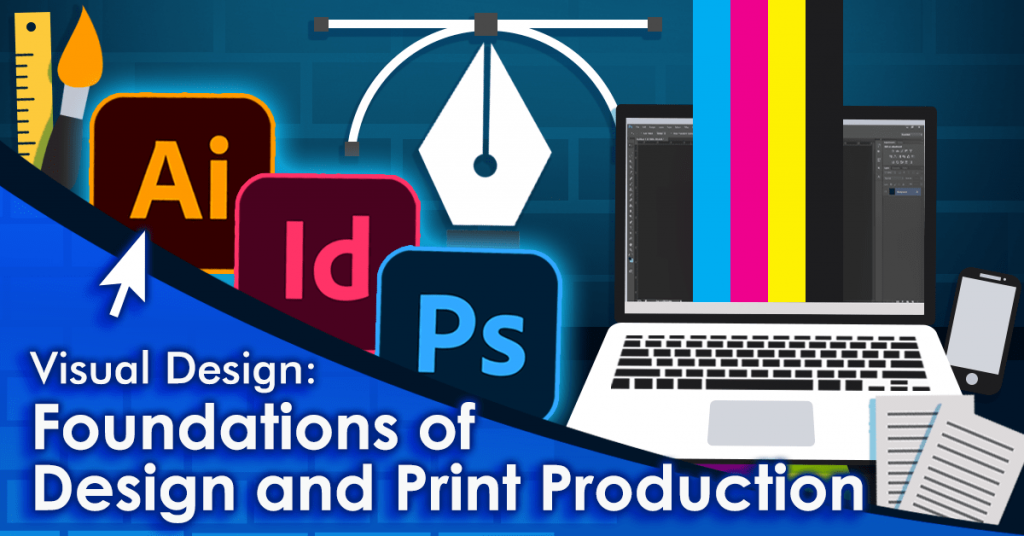Visual Design: Foundations of Design & Print Production (Adobe Certification)
Duration: to be announced
Fee: to be announced
COURSE DETAILS
COMING SOON...
Overview
Visual Design: Foundations of Print Design and Print Production is a project-based curriculum that develop career and communication skills in graphic design, illustration and print and digital media production, using Adobe tools. Visual Design develops four key skill areas:
- Project management and collaboration
- Design
- Research and communication
- Professional digital photography, illustration, and page layout using Adobe tools
Visual Design addresses each of these areas, using a project-based approach. Each project has phases that follow a design and development process, from project planning and analysis to evaluation and distribution. Students gain experience through real-world projects that help them better understand the roles and processes across a broad range of careers involving visual design. To simulate a professional work environment, students gradually migrate their design work from an individual process to a group process, focused on personal and client work. Design work by its very nature is iterative, so the projects contain activities that require students to evaluate and then redesign and rework their communications. Specific attention has been paid to developing concepts and principles for thorough, effective design. This content prepares students for the following Adobe Certified Associate exams:
- Adobe Certified Associate exams for Visual Communication with Photoshop
- Graphic Design and Illustration with Adobe Illustrator, and
- Print and Digital Media Publication with Adobe InDesign
The content also prepares students for the Visual Graphic Design NC III national assessment.
Expected Output
First part
The first part of Visual Design develops skills that lay the foundation for photography and producing print-ready communications: graphic design principles, visual comps, illustration, print production development, shared project management skills such as interviewing and project scheduling, peer review, and redesign. Project activities focus on developing effective communications that can be deployed in print, on the web, or in a video. Students develop a variety of images, graphics, a logo, a business card, and a client advertisement. They produce design documents and visual comps that clients review. Students culminate the semester with a portfolio project during which they reflect on the skills and topics they’ve covered thus far and begin to explore the career areas that interest them in visual design.
The key skills emphasized in this part are:
- Soft skills such as interviewing and responding to feedback
- Designing for a variety of audiences and needs
- Problem solving that helps support multiple perspectives
- Illustration and drawing
- Page layout
- The design process and effective communication
- Peer teaching and evaluation in a collaborative environment
- Technical image manipulation and print publishing skills
In the first part, students use Adobe Photoshop and Adobe Illustrator to develop and edit images, graphics, and illustrations. They use Adobe InDesign to design and build layouts and print materials. They use Adobe Acrobat Pro to review and improve content and produce print-ready materials..
Second part
The second part of Visual Design builds on student design and development skills by focusing on longer print production projects as well as more in-depth content and advanced techniques for graphics and layout development. Students continue to work on teams to produce rich print communications such as brochures, newsletters, and yearbooks. They focus on effective graphic design, project management, design specifications, and iterative development. They develop graphic-design and
print-production skills that solve specific communication challenges to meet client and audience needs. They build technical skills to address project needs and learn to track complex projects. Students culminate the second part of the Visual Design with a portfolio redesign that has them project forward on their academic and
career aspirations, goals, and interests.
The key skills emphasized in this part are:
- Project management skills such as task management, client management, milestone tracking, and contingency planning.
- Reusable design elements.
- Communication with peers and team members, using project plans or specifications
- Design and redesign
- Technical graphic- and print-production skills such as creating vector-based graphics and filters
- Design solutions, including multi-page and double-page layouts
In the second part of the program, students enhance their skills in Adobe Photoshop, Adobe Illustrator, and Adobe
InDesign to create their designs.
| First Part Projects | Second Part Projects |
| Project 1: Collages and photography | Project 6: Brochures |
| Project 2: Logos | Project 7: Newsletters |
| Project 3: Business Cards | Project 8: Mini-yearbooks |
| Project 4: Advertisements | Project 9: Final Portfolio |
| Project 5: Mid-term Portfolio |
Note: This is an official course overview and outline from Adobe Certified Associate training course, Visual Design: Foundations of Design and Print Production utilized by PCCI in developing its own activities, projects, and curriculums that are customized for its classroom.

